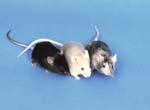Oca2p-un
Spontaneous Allele Detail
|
|
| Symbol: |
Oca2p-un |
| Name: |
oculocutaneous albinism II; pink-eyed dilution unstable |
| MGI ID: |
MGI:1856123 |
| Synonyms: |
p', pm, pun |
| Gene: |
Oca2 Location: Chr7:55889508-56186266 bp, + strand Genetic Position: Chr7, 33.44 cM
|
| Alliance: |
Oca2p-un page
|
|
Oca2p-un+J/Oca2p-un+J, Oca2p-un/Oca2p-un and mosaic mice
Show the 1 phenotype image(s) involving this allele.
|

|
|
|
|
| Allele Type: |
|
Spontaneous |
| Mutation: |
|
Transposon insertion
|
| |
|
Mutation details: This mutation comprises a head-to-tail tandem duplication of ~70 kb and includes an intracisternal A particle (IAP) that is present in the wild-type allele. The ~1.3-kb larger mutant transcript contains a tandem repetition of nucleotides 765-2067, derived from exons 6-18, with apparent breakpoints in introns 5 and 18; the duplicated region encodes amino acids 212-645, encompassing transmembrane domains 2-7, with serine substituted for alanine at the junction of the second copy. Several phenotypic revertant alleles have been shown to have lost one copy of the duplicated segment.
(J:3762, J:11138, J:32816)
|
| Inheritance: |
|
Recessive |
|
|
View phenotypes and curated references for all genotypes (concatenated display).
|
|
|
|
|
|
pun, pink-eyed unstable, recessive. This mutation arose spontaneously in the C57BL/6J strain. Homozygotes resemble p/p mice phenotypically, but pun reverts somatically to wild-type with high frequency. The reversion rate varies with age, being highest at 2 and at 10 days of gestation, and with genotype of parents, being higher in pun homozygous progeny of heterozygous parents (pun/+ or pun/p mated inter se) than of homozygous pun parents (J:5526). Whitney and Lamoreux (J:6739) suggest that pun may have been produced by insertion of a transposable element into the wild-type p locus gene, frequent excision of the element being responsible for the high reversion rate. Subsequently Brilliant et al. (J:2230) have shown that in the pun mutation, coding sequences of the p gene are interrupted by a head-to-tail tandem duplication of genomic DNA, one copy of which appears to be lost in revertant mice (J:3762). In the pigmented retinal epithelium, darkly pigmented revertant cells occur with greater frequency in the more distal or anterior part of the epithelial layer than in the proximal part near the optic nerve, indicating that the rate of reversion is conditioned by the tissue environment (J:7305). Homozygous pun mice, in common with some other mutations that reduce pigmentation, have a reduced number of projections of retinal ganglion cells to the ipsilateral lateral geniculate nucleus (J:6064).
|
| Original: |
J:85780 Wolfe HG, Two unusual mutations affecting coat color in the mouse. Proc 11th Int Cong Genet. 1963;:251 |
| All: |
31 reference(s) |
|
 Analysis Tools
Analysis Tools





